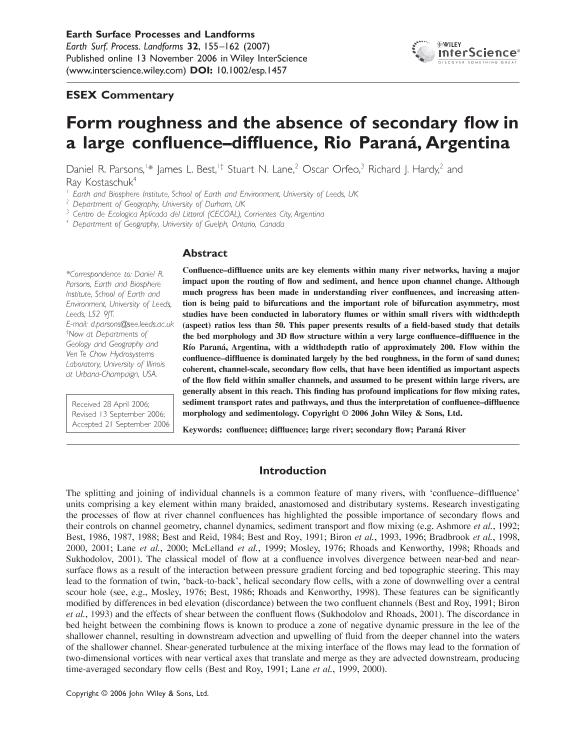Mostrar el registro sencillo del ítem
dc.contributor.author
Parsons, Daniel R.

dc.contributor.author
Best, James L.

dc.contributor.author
Lane, Stuart N.

dc.contributor.author
Orfeo, Oscar

dc.contributor.author
Hardy, Richard J.

dc.contributor.author
Kostaschuck, Ray
dc.date.available
2018-04-23T20:37:09Z
dc.date.issued
2007-01
dc.identifier.citation
Parsons, Daniel R.; Best, James L.; Lane, Stuart N.; Orfeo, Oscar; Hardy, Richard J.; et al.; Form roughness and the absence of secondary flow in a large confluence-diffluence, Rio Paraná, Argentina; John Wiley & Sons Ltd; Earth Surface Processes And Landforms; 32; 1; 1-2007; 155-162
dc.identifier.issn
0197-9337
dc.identifier.uri
http://hdl.handle.net/11336/43143
dc.description.abstract
Confluence–diffluence units are key elements within many river networks, having a major impact upon the routing of flow and sediment, and hence upon channel change. Although much progress has been made in understanding river confluences, and increasing attention is being paid to bifurcations and the important role of bifurcation asymmetry, most studies have been conducted in laboratory flumes or within small rivers with width:depth (aspect) ratios less than 50. This paper presents results of a field‐based study that details the bed morphology and 3D flow structure within a very large confluence–diffluence in the Río Paraná, Argentina, with a width:depth ratio of approximately 200. Flow within the confluence–diffluence is dominated largely by the bed roughness, in the form of sand dunes; coherent, channel‐scale, secondary flow cells, that have been identified as important aspects of the flow field within smaller channels, and assumed to be present within large rivers, are generally absent in this reach. This finding has profound implications for flow mixing rates, sediment transport rates and pathways, and thus the interpretation of confluence–diffluence morphology and sedimentology.
dc.format
application/pdf
dc.language.iso
eng
dc.publisher
John Wiley & Sons Ltd

dc.rights
info:eu-repo/semantics/openAccess
dc.rights.uri
https://creativecommons.org/licenses/by-nc-sa/2.5/ar/
dc.subject
Form Roughness
dc.subject
Secondary Flow
dc.subject
Confluences
dc.subject
Difluences
dc.subject
Large Rivers
dc.subject
Parana River
dc.subject.classification
Meteorología y Ciencias Atmosféricas

dc.subject.classification
Ciencias de la Tierra y relacionadas con el Medio Ambiente

dc.subject.classification
CIENCIAS NATURALES Y EXACTAS

dc.title
Form roughness and the absence of secondary flow in a large confluence-diffluence, Rio Paraná, Argentina
dc.type
info:eu-repo/semantics/article
dc.type
info:ar-repo/semantics/artículo
dc.type
info:eu-repo/semantics/publishedVersion
dc.date.updated
2018-04-16T13:45:47Z
dc.identifier.eissn
1096-9837
dc.journal.volume
32
dc.journal.number
1
dc.journal.pagination
155-162
dc.journal.pais
Reino Unido

dc.description.fil
Fil: Parsons, Daniel R.. University of Leeds; Reino Unido
dc.description.fil
Fil: Best, James L.. University of Leeds; Reino Unido
dc.description.fil
Fil: Lane, Stuart N.. University Of Durham; Reino Unido
dc.description.fil
Fil: Orfeo, Oscar. Consejo Nacional de Investigaciones Científicas y Técnicas. Centro Científico Tecnológico Conicet - Nordeste. Centro de Ecología Aplicada del Litoral. Universidad Nacional del Nordeste. Centro de Ecología Aplicada del Litoral; Argentina
dc.description.fil
Fil: Hardy, Richard J.. University Of Durham; Reino Unido
dc.description.fil
Fil: Kostaschuck, Ray. University of Guelph; Canadá
dc.journal.title
Earth Surface Processes And Landforms

dc.relation.alternativeid
info:eu-repo/semantics/altIdentifier/doi/http://dx.doi.org/10.1002/esp.1457
dc.relation.alternativeid
info:eu-repo/semantics/altIdentifier/url/https://onlinelibrary.wiley.com/doi/abs/10.1002/esp.1457
Archivos asociados
